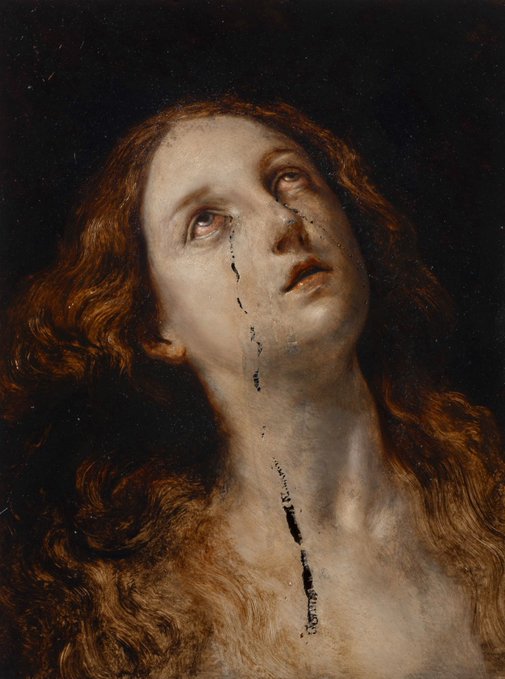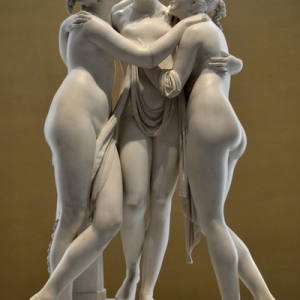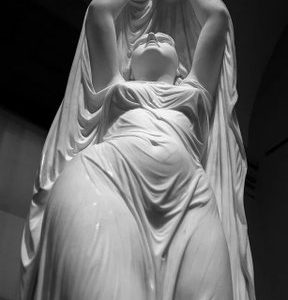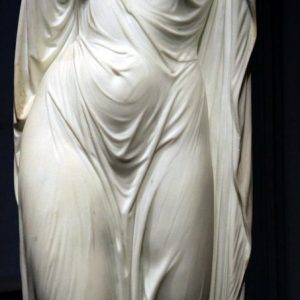Nicola Samorì’s 2020 painting “Lacrimosa” is a captivating and emotionally charged work that intertwines classical artistry with contemporary sensibilities. Here we’ll delve into the depths of this piece, examining its aesthetics, thematic elements, and the profound meaning it conveys. Samorì, known for his skill in reinterpreting classical techniques and themes through a modern lens, presents a work that is both visually striking and rich in symbolic significance.
“Lacrimosa,” a term derived from the Latin word for “weeping,” immediately sets a somber, introspective tone for the painting. The title itself is a direct reference to the “Lacrimosa” section of the Requiem Mass in the Catholic tradition, which speaks of the day of judgment and the tears that will be shed. This connection to a religious requiem not only influences the emotional resonance of the piece but also roots it in a historical and cultural context.
The painting, consistent with Samorì’s style, showcases a masterful blend of classical and contemporary techniques. He employs a dark, almost monochromatic palette, creating an atmosphere of melancholy and introspection. The brushwork is simultaneously precise and fluid, allowing for a dynamic interplay of light and shadow that gives the painting a three-dimensional quality. This technique pays homage to the old masters while infusing the work with a distinctly modern sensibility.
At the center of “Lacrimosa” is a figure that captures the viewer’s attention. This figure, rendered with a blend of realism and abstraction, embodies the themes of grief and reflection. The facial expression, though partially obscured, conveys a profound sense of sorrow and resignation. The eyes, in particular, are a focal point, brimming with an intensity that speaks of deep emotional turmoil. This portrayal of human emotion is a hallmark of Samorì’s work, reflecting his interest in the depths of the human psyche.
The composition of “Lacrimosa” further enhances its thematic impact. The figure is positioned in a way that suggests both isolation and vulnerability. This placement, along with the sparse background, focuses the viewer’s attention on the emotional state of the subject. The lack of contextual elements in the painting allows for a universal interpretation of the theme of mourning, transcending specific cultural or historical boundaries.
Samorì’s use of symbolism in “Lacrimosa” is subtle yet powerful. The painting can be seen as a meditation on the human condition, particularly the inevitability of sorrow and the universal experience of loss. The religious overtones, coupled with the raw portrayal of emotion, create a layered narrative that invites contemplation on themes such as mortality, redemption, and the human capacity for suffering.
Moreover, “Lacrimosa” reflects Samorì’s ongoing exploration of the degradation and transformation of classical forms. The painting, while deeply rooted in classical aesthetics, is marked by a sense of decay and disintegration. This aspect of the work speaks to the impermanence of beauty and the transient nature of human existence. Samorì’s technique of partially deconstructing his images serves to highlight the fragility of life and the fleeting nature of our experiences.
The painting also engages with contemporary dialogues in the art world, challenging traditional notions of beauty and perfection. Samorì’s approach, which often involves altering or even damaging his canvases, underscores a break from conventional standards. This deliberate act of destruction and reconstruction within his work can be interpreted as a commentary on the process of creation and decay, both in art and in life.
In the broader context of Samorì’s oeuvre, “Lacrimosa” stands as a poignant example of his ability to bridge past and present. His paintings are often seen as a dialogue with the works of the old masters, yet they are distinctly modern in their execution and conceptualization. “Lacrimosa,” with its emotional depth and technical prowess, is a testament to Samorì’s skill in creating art that is both reverential and revolutionary.
In conclusion, Nicola Samorì’s “Lacrimosa” is a profound work that masterfully blends classical artistry with modern expression. Its exploration of themes such as grief, mortality, and the human condition resonates deeply with contemporary audiences. The painting’s emotional intensity, combined with its technical sophistication, makes it a compelling piece in the realm of modern art. Through “Lacrimosa,” Samorì continues his exploration of the dynamic relationship between destruction and creation, offering a powerful reflection on the enduring complexities of the human experience.









